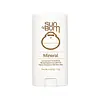What's inside
What's inside
 Key Ingredients
Key Ingredients

 Benefits
Benefits

 Concerns
Concerns

 Ingredients Side-by-side
Ingredients Side-by-side

Titanium Dioxide 0.7%
Cosmetic ColorantZinc Oxide 17%
Cosmetic ColorantCyclopentasiloxane
EmollientCoco-Caprylate
EmollientIsododecane
EmollientCoco-Caprylate/Caprate
EmollientDimethicone Crosspolymer
Emulsion StabilisingSilica Dimethyl Silylate
EmollientDimethicone/Bis-Isobutyl PPG-20 Crosspolymer
EmollientArgania Spinosa Kernel Oil
EmollientTocopheryl Acetate
AntioxidantC12-15 Alkyl Benzoate
AntimicrobialPolyglyceryl-3 Polyricinoleate
EmulsifyingDimethicone
EmollientCI 77492
Cosmetic ColorantWater
Skin ConditioningIsostearic Acid
CleansingPropanediol
SolventEthylhexylglycerin
Skin ConditioningPEG/PPG-18/18 Dimethicone
EmulsifyingBisabolol
MaskingAlumina
AbrasiveHydrogen Dimethicone
CI 77491
Cosmetic ColorantPolyhydroxystearic Acid
EmulsifyingCI 77499
Cosmetic ColorantBuddleja Officinalis Flower Extract
UV FilterTriethoxycaprylylsilane
Hydrangea Arborescens Root Extract
Skin ConditioningMorus Alba Root Extract
BleachingPolysorbate 20
EmulsifyingResveratrol
AntioxidantScutellaria Lateriflora Extract
Skin ConditioningCaprylyl Glycol
EmollientHexylene Glycol
EmulsifyingPentapeptide-21
Skin ConditioningTitanium Dioxide 0.7%, Zinc Oxide 17%, Cyclopentasiloxane, Coco-Caprylate, Isododecane, Coco-Caprylate/Caprate, Dimethicone Crosspolymer, Silica Dimethyl Silylate, Dimethicone/Bis-Isobutyl PPG-20 Crosspolymer, Argania Spinosa Kernel Oil, Tocopheryl Acetate, C12-15 Alkyl Benzoate, Polyglyceryl-3 Polyricinoleate, Dimethicone, CI 77492, Water, Isostearic Acid, Propanediol, Ethylhexylglycerin, PEG/PPG-18/18 Dimethicone, Bisabolol, Alumina, Hydrogen Dimethicone, CI 77491, Polyhydroxystearic Acid, CI 77499, Buddleja Officinalis Flower Extract, Triethoxycaprylylsilane, Hydrangea Arborescens Root Extract, Morus Alba Root Extract, Polysorbate 20, Resveratrol, Scutellaria Lateriflora Extract, Caprylyl Glycol, Hexylene Glycol, Pentapeptide-21
Zinc Oxide 19.2%
Cosmetic ColorantCocos Nucifera Oil
MaskingPersea Gratissima Oil
Skin ConditioningLimnanthes Alba Seed Oil
Skin ConditioningLinum Usitatissimum Seed Oil
PerfumingOryza Sativa Bran Wax
Skin ConditioningEuphorbia Cerifera Wax
Butyloctyl Salicylate
Skin ConditioningCopernicia Cerifera Wax
Ozokerite
Emulsion StabilisingButyrospermum Parkii Butter
Skin ConditioningOryzanol
Skin ConditioningCarthamus Tinctorius Seed Oil
MaskingTheobroma Cacao Seed Butter
EmollientJojoba Esters
EmollientTocopherol
AntioxidantBisabolol
MaskingZinc Oxide 19.2%, Cocos Nucifera Oil, Persea Gratissima Oil, Limnanthes Alba Seed Oil, Linum Usitatissimum Seed Oil, Oryza Sativa Bran Wax, Euphorbia Cerifera Wax, Butyloctyl Salicylate, Copernicia Cerifera Wax, Ozokerite, Butyrospermum Parkii Butter, Oryzanol, Carthamus Tinctorius Seed Oil, Theobroma Cacao Seed Butter, Jojoba Esters, Tocopherol, Bisabolol
 Reviews
Reviews

Ingredients Explained
These ingredients are found in both products.
Ingredients higher up in an ingredient list are typically present in a larger amount.
Bisabolol is famous for its skin soothing properties. It does this by blocking inflammatory signals, helping to reduce your body's reaction to irritation.
This ingredient also interferes with the process of hyperpigmentation. This can help with reducing dark spots and uneven tone.
Bisabolol is an antioxidant. Antioxidants help fight free-radicals. Free-radicals are molecules that may damage your skin cells. By fighting these free-radicals, Bisabolol may slow down signs of aging.
Studies have shown Bisabolol to have antimicrobial properties and may be a fungicide. These properties help preserve a product's shelf life.
All these properties makes bisabolol a great skin barrier helper ingredient.
Bisabolol also helps the absorption of other ingredients.
Note: Synthetic Bisabolol has been shown to be less effective.
Learn more about BisabololZinc Oxide is a mineral broad-spectrum UV filter; it is the broadest UVA and UVB reflector approved by the FDA. It also has skin protectant and skin soothing properties.
Zinc oxide is one of the most effective broad-spectrum UV filters. It protects against UVB, UVAII, and UVAI. In comparison to its counterpart titanium dioxide, zinc oxide provides uniform and extended UVA protection.
Another great benefit? This ingredient is highly photostable so it won't degrade easily under sunlight.
A common myth is that mineral UV filters are widely believed to primarily reflect UV light.
However, modern research shows titanium dioxide absorbs UV radiation like chemical filters (~95% absorption & 5% reflection).
Zinc oxide has great skin soothing properties so you'll likely find this in sunscreens formulated for sensitive skin or babies/children. It is unlikely to cause "eye sting" like other sunscreen ingredients.
Regulatory agencies consider zinc oxide to be non-toxic and safe. It has also been shown to not penetrate the skin.
Unfortunately, this ingredient does leave a visible white cast. This is why mineral sunscreens are often less cosmetically elegant than chemical or hybrid ones.
In cosmetics, zinc oxide can be found in both non-nano and nano-sized forms. The nano version is used to reduce white cast and improve the texture of sunscreen formulas.
There are ongoing concerns surrounding nano-zinc oxide's impact on marine ecosystems and whether it can be absorbed into skin.
Regarding marine ecosystems and coral reefs, there is no conclusive evidence that any form of zinc oxide (or any other sunscreen ingredients) will cause harm. The science is still developing but many consumers are keeping a close eye on this issue.
Please note, many destinations have reef-safety sunscreen rules. For instance, the U.S. Virgin Islands advises all visitors to use non-nano mineral sunscreens.
There has also been some stir about whether micronized or nano zinc oxide has potential photoxicity and absorption through the skin/lungs.
An in-vitro (done in a test tube or petri dish) study demonstrated micronized zinc oxide to have potential phototoxicity. There's no need to fret; the EU Commission's Scientific Committee on Consumer Safety has stated, "The relevance of these findings needs to be clarified by appropriate investigations in vivo." Or in other words, further studies done on living organisms are needed to prove this.
Current research shows zinc oxide nanoparticles do not penetrate intact or sunburned skin. They either remain on the surface or in the outermost layer of dead skin (stratum corneum).
Zinc oxide is one of only two classified mineral UV filters with titanium dioxide being the other one.
Fun fact: Zinc has been used throughout history as an ingredient in paint and medicine. An Indian text from 500BC is believed to list zinc oxide as a salve for open wound. The Ancient Greek physician Dioscorides has also mentioned the use of zinc as an ointment in 1AD.
Learn more about Zinc Oxide